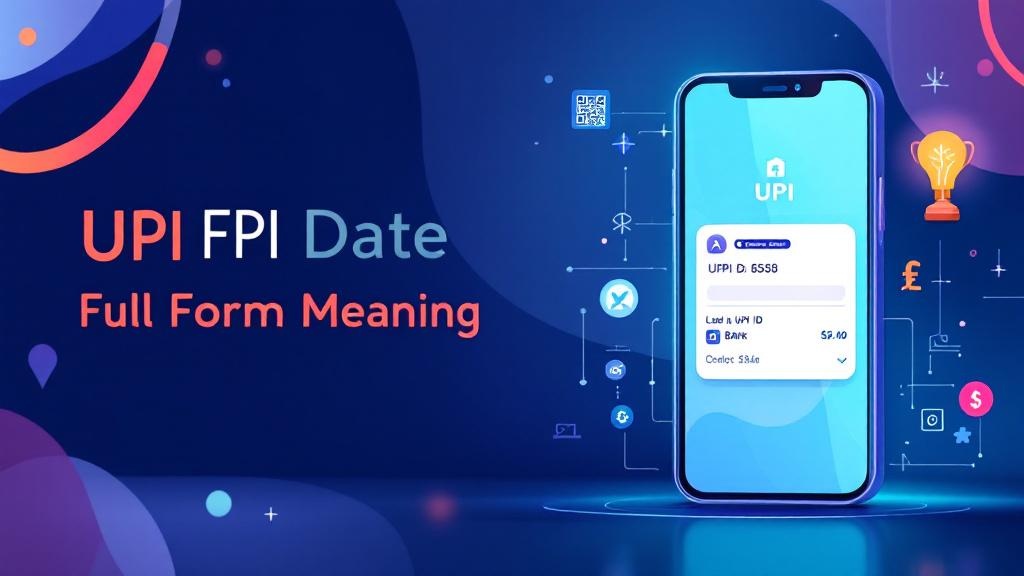In the digital age, technology has transformed almost every aspect of our lives, including how we handle our finances. One of the most impactful innovations in India’s banking sector has been the Unified Payments Interface (UPI). With its seamless and instant fund transfer capabilities, UPI has revolutionized the way we send and receive money. If you’ve ever wondered about the UPI full form meaning and how it functions within the banking system, you’re in the right place!
In this article, we’ll explore the UPI full form, how it works, its importance in India’s digital ecosystem, and much more. So, whether you’re new to UPI or just looking to understand it better, this guide will answer all your questions.
What is UPI? A Definition and Meaning
Let’s begin with the most basic question: What is UPI?
UPI stands for Unified Payments Interface, a digital payment system developed by the National Payments Corporation of India (NPCI) in collaboration with major banks and the Reserve Bank of India (RBI). Launched in 2016, UPI was designed to facilitate real-time bank transfers and make the entire process more user-friendly and accessible. It allows users to send or receive money instantly between two bank accounts using a mobile device.
The system works by linking a user’s bank account to a unique UPI ID, enabling them to make digital payments, transfer funds, and even pay for goods and services online—all in real-time.
UPI Full Form in Banking
In banking, UPI full form meaning refers to the unified platform that enables instantaneous, hassle-free transactions. Gone are the days of waiting hours or even days for a fund transfer to process. With UPI, transactions occur in real-time, making it one of the most efficient payment methods available today. Whether you’re paying bills, transferring money to a friend, or shopping online, UPI offers unmatched convenience and security.
UPI Full Form in India: A Game-Changer for Digital Payments
The UPI full form in India holds significant importance in the nation’s shift towards cashless transactions and digital India. Prior to UPI, people relied heavily on physical banking methods like cash deposits, cheque transfers, and even traditional NEFT or RTGS methods for online fund transfers. While these systems were effective, they had limitations like delays, higher charges, and manual errors.
UPI changed all of that by providing a platform that connects multiple banks and payment systems, making cashless transactions easier, quicker, and more secure. This shift is also aligned with the government’s vision of a digital India initiative, which aims to promote digital literacy and create an infrastructure that empowers every citizen with digital tools for financial transactions.
UPI Full Form with Example
Let’s look at a practical example to understand how UPI works:
Suppose you want to pay your friend for dinner. Here’s how the UPI full form with example might play out:
You open your UPI-enabled mobile banking app (like Google Pay, PhonePe, or Paytm).
You enter your friend’s UPI ID (e.g., friend@upi).
You enter the amount, say ₹500.
You authenticate the transaction using your PIN.
In a matter of seconds, the ₹500 is transferred directly from your bank account to your friend’s account—instantly and without any fees.
This real-time transaction demonstrates the power and simplicity of UPI, making UPI full form meaning clear for anyone unfamiliar with it.
UPI Full Form Today: Why It’s So Popular
Since its launch, UPI has gained immense popularity in India. Today, it’s one of the most widely used payment systems, thanks to its efficiency, security, and ease of use. Let’s break down why UPI is so popular:
Instant Fund Transfers: UPI allows for real-time bank transfers, meaning that money moves from one account to another instantly.
24/7 Availability: Unlike traditional banking hours, UPI transactions are available around the clock, including weekends and holidays.
No Transaction Fees: UPI transactions are mostly free of charge, making it an affordable option for everyone.
Wide Accessibility: UPI is compatible with a range of mobile banking apps, meaning you can make payments from multiple platforms.
Security: With two-factor authentication (PIN), UPI ensures a high level of security for your financial transactions.
Given all these advantages, UPI full form and usage has expanded rapidly, with millions of transactions happening daily.
UPI Full Form for Students: How It Benefits Young People
UPI has proved to be particularly beneficial for students in India, offering them a quick and easy way to manage their finances. Whether it’s paying for online courses, splitting rent, or buying snacks from a store, UPI provides an accessible and secure payment method for the younger generation.
For students, UPI full form for students is more than just a tool for fund transfers; it’s a gateway to financial independence. The ease of access through mobile apps means that students don’t need to visit a bank or use cash—everything can be done digitally. Additionally, the ability to set up UPI IDs for different uses, such as groceries or tuition fees, helps students stay organized.
UPI Meaning in Bank Transaction
When we talk about UPI meaning in bank transaction, it refers to how UPI facilitates banking transactions without needing the customer to visit the bank physically. With UPI, users can:
Send money instantly to anyone using just their UPI ID.
Pay utility bills such as electricity, water, and mobile recharge bills.
Perform QR code payments at retail outlets or online merchants.
Split bills with friends or colleagues with ease.
UPI has truly revolutionized the way we conduct online fund transfer operations, making transactions faster and more efficient than traditional methods like NEFT or RTGS.
The Future of UPI: Trends and Innovations
With UPI’s widespread adoption, the future looks bright. Here are a few trends and innovations we can expect to see:
Higher UPI Transaction Limit: In response to growing demand, the UPI transaction limit may be raised, allowing for larger transactions to be completed digitally.
Cross-border UPI Payments: As UPI continues to evolve, it may expand beyond India’s borders, enabling real-time cross-border payments between different countries.
AI and UPI Integration: The integration of AI with UPI could enable personalized payment solutions, automated financial advice, and better fraud detection.
UPI and Blockchain Technology: The future could bring blockchain technology into the UPI ecosystem, enhancing security and transaction transparency.
FAQs: Everything You Need to Know About UPI
1. What is the UPI full form?
The UPI full form is Unified Payments Interface, a digital payment system developed by the National Payments Corporation of India (NPCI).
2. What does UPI stand for in banking?
In banking, UPI refers to a unified platform that allows users to send and receive money instantly, 24/7, without the need for physical visits to the bank.
3. What is UPI used for?
UPI is used for various purposes, including real-time bank transfers, mobile payments, QR code payments, bill payments, and more.
4. How does UPI benefit students?
UPI offers students a simple, secure, and fast way to manage their finances, including paying for courses, splitting bills, or making online purchases.
5. Is UPI free to use?
Yes, most UPI transactions are free of charge, making it an affordable and convenient way to send and receive money.
6. How safe is UPI?
UPI is highly secure, with two-factor authentication (PIN) required for each transaction, ensuring that only authorized users can access and use their accounts.
7. What is the UPI transaction limit?
Currently, the UPI transaction limit is ₹1,00,000 per transaction, although this may vary depending on your bank and type of transaction.
Conclusion: UPI Full Form and Its Meaning in the Digital Age
To sum up, UPI full form meaning has become a central part of India’s digital payment system. With its real-time, secure, and user-friendly capabilities, UPI has not only transformed how we conduct financial transactions but has also paved the way for a cashless economy.
As the digital landscape continues to evolve, UPI’s role in the future of banking and mobile payments is undoubtedly significant. Whether you’re using it for QR code payments, transferring money, or paying your utility bills, UPI has made financial transactions simpler, faster, and more accessible to all.
So, the next time you make a UPI transaction, remember how this powerful tool is shaping the future of online banking in India and beyond.








Comments (0)